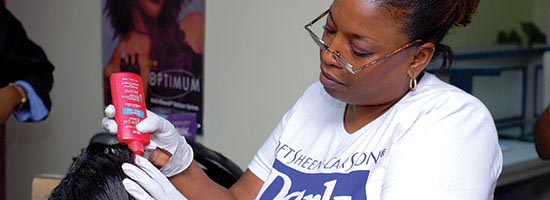Persons experiencing hair disorders are advised to visit a trichologist, who is someone that specialises in disorders of the hair and scalp. Their questions and inspection of the scalp and hair will often reveal what is causing hair worries. Noted trichologist and hair care professional, Karl Richmond, was kind enough to speak to Buzzz about some of the issues many of us face with our crowning glory.
Advising that the general term for hair loss is alopecia, Karl observes that there are many factors that cause hair breakage. For example, stress related hair breakage has its own pattern, which is manifested by little oval shaped bald patches usually seen after stressful periods. There is need to identify and manage what is causing this stress to prevent further hair loss.
The answers to some of the questions posed by a trichologist may reveal that the client has poor eating habits, which ultimately leads to poor nutrition. Vitamins that will assist with the re-growing process of your hair fall into the Vitamin B complex, which helps to manage stress. It is comprised of Biotin, which helps to re-grow hair and folic acid, which is necessary for the production and maintenance of new cells. Using this complex for about a month will help to revive hair growth.
Another factor causing hair loss includes improper services done in or out of the salon. Karl stresses that “in-house” hairdressers must use neutralising shampoo to rinse the relaxer out of the hair. This is because normal conditioning shampoos do not stop the active chemicals in hair relaxers. “So do it yourselfers are being cautioned to follow manufacturers instructions during the relaxer service; if not, your hair will break,” stresses Karl.

Other services that cause hair to weaken are permanent hair colours or the streaking or bleaching of the hair. He explained that treatments that render your hair lighter in shade use stronger formulations, causing hair to weaken. This contrasts with colours that darken your hair, as these are not as strong. Weaker or milder relaxers should be used on colour treated hair, he warned, or you risk hair breakage.
One of the most common hair disorders is trichoptilosis or split ends, in which the hair ends look like frayed rope. The only solution to this condition is to have the ends trimmed, advises Karl. This condition does not usually require a hair cut. He recommends Dark & Lovely Moisture Seal Deep Conditioner or the Dry Hair Healer to assist in strengthening tresses after hair is trimmed.
Our avid swimmers typically experience hair that is quite dry and dull due to the chlorine found in the pool, or in the case of beach lovers, salt water. He suggests shampooing and using moisture treatments after coming in contact with the swimming pool or salt water.
Many persons believe that natural hair does not require much care. Not so, says Karl. In fact, he advises that those who sport natural hair should wash just as often as those who have relaxed hair styles, ideally once a week. Surprisingly, hair and scalp that are dirty are quite susceptible to disorders caused by the use of dirty combs and brushes. So wash these grooming tools regularly also. The trichologist also advises using a shampoo that does not contain lots of detergent, which can cause hair to dry out. Unprocessed hair is a bit drier because it is curly. This curl prevents natural oil reaching along the hair shaft as it easily does in persons with straight hair (such as Caucasians). Another no-no is using bath soap to wash your natural hair – this is too harsh and will lead to wiry, dull hair. Conditioning shampoos are to be used every week. Men are advised to use conditioning shampoos as well.
Use of moisture shampoos on natural hair is highly recommended because they contain much less detergent. In fact, Karl notes that persons with natural hair can shampoo their tresses even twice a week with moisture shampoos. He suggests using Dark & Lovely’s Beautiful Beginnings which is in the Kiddies line. These are very gentle and allow for easy comb out after shampooing.

Many hair disorders are in fact caused by medical conditions. For example, lupus (an autoimmune disease in which the immune system attacks the body’s cells and tissue, resulting in inflammation and tissue damage) results in blotches on the scalp while another condition, hypothyroidism (in this case the thyroid gland does not produce enough thyroid hormone), will cause hair loss. Basically, hair suffers when the body is undergoing medical stress because the body in trying to hold on to the essential nutrients needed to protect itself and in the process it sheds hair, which is not essential to a human’s wellbeing.
Some women who have had babies might notice hair loss four months after having the baby. This is termed “post partum alopecia”. Fortunately, this is a temporary situation that happens because the body is regulating itself by trying to return to pre-pregnancy hormone levels. So hair normally re-grows after a few weeks.
Some medications cause hair breakage, such as antibiotics and those used for thyroid and ulcer conditions. Some antidepressants also cause hair loss.
After this form is completed, Soft Sheen then advises the client of what is needed to restore the health of his/her hair. These items are then purchased from the beauty supply store and should be used by a personal stylist for treatment purposes.
In some cases, nutritional advice may be given or a medical doctor may have to be consulted.

